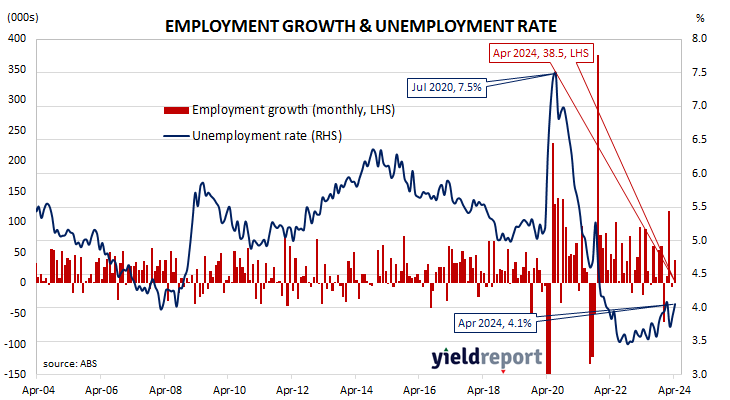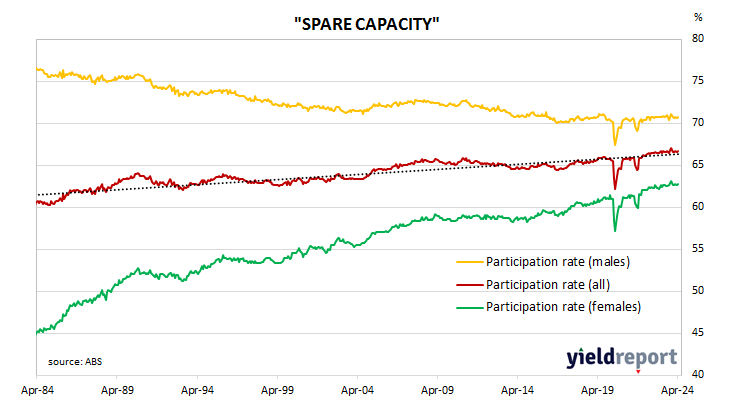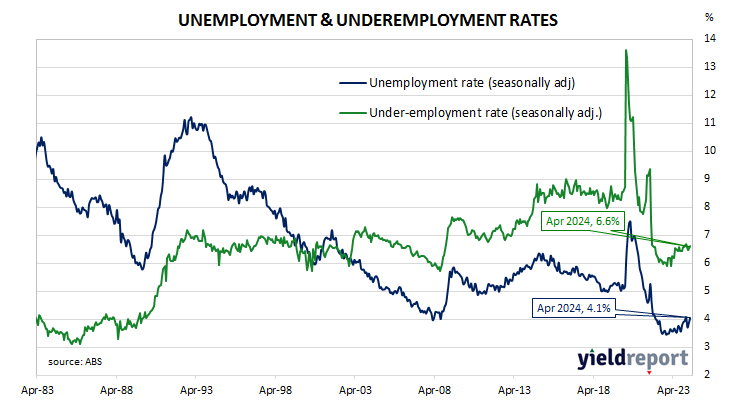Summary: Employment up 38,500 in April, greater than expected; Westpac: Labour demand cooler but has translated into only gradual softening in employment growth; ACGB yields fall heavily; rate-cut expectations firm noticeably; ANZ: fall in hours worked “noteworthy”; participation rate ticks up to 66.7%; jobless rate rises from 3.9% to 4.1%; more part-time jobs, more full-time jobs; aggregate work hours steady; underemployment rate ticks up to 6.6%.
Australia’s period of falling unemployment came to an end in early 2019 when the jobless rate hit a low of 4.9%. It then averaged around 5.2% through to March 2020, bouncing around in a range from 5.1% to 5.3%. Leading indicators such as ANZ-Indeed’s Job Ads survey and NAB’s capacity utilisation estimate suggested the unemployment rate would rise in the June 2020 quarter and it did so, sharply. The jobless rate peaked in July 2020 but fell below 7% a month later and then trended lower through 2021 and 2022.
The latest Labour force figures have now been released and they indicate the number of people employed in Australia according to ABS definitions increased by 38,500 in April. The result was greater than the 21,900 rise which had been generally expected and in contrast with March’s upwardly-revised fall of 5,900.
“Labour demand has certainly cooled over the past year, but it has only translated into a gradual softening in employment growth,” said Westpac economist Ryan Wells. “Easing labour demand appeared more clearly in average hours worked over the second half of last year. Since then, it has shown few signs of extended weakness.”
Domestic Treasury bond yields fell heavily across the curve on the day, slightly outpacing the significant falls of US Treasury yields overnight. By the close of business, the 3-year ACGB yield had shed 12bps to 3.83% while 10-year and 20-year yield both finished 13bps lower at 4.20% and 4.50% respectively.
In the cash futures market, expectations regarding rate cuts in the next twelve months firmed noticeably. At the end of the day, contracts implied the cash rate would remain close to the current rate for the next few months and average 4.31% through June and 4.315% in August. However, November contracts implied 4.24%, February 2025 contracts implied 4.16% while May 2025 contracts implied 4.035%, 29bps less than the current cash rate.
“Hours worked were unchanged in the month to be 0.8% lower over the year [and] base effects suggest positive yearly growth next month,” ANZ Australian Head of Economics said Adam Boyton. “Still, the fall in hours worked is noteworthy. Over the past 25 years larger year-on-year falls in hours worked have only been seen during the pandemic, the GFC and the early 2000s mid-cycle slowdown.”
The participation rate ticked up from March’s figure of 66.6% to 66.7% as the total available workforce increased by 68,800 to 14.984 million while the number of unemployed persons increased by 30,300 to 604,200. As a result, the unemployment rate increased from 3.9% after revisions to 4.1%.
The aggregate number of hours worked across the Australian economy remained steady (after rounding) as 44,600 residents gained part-time positions and 6,100 residents lost full-time positions. On a 12-month basis and after revisions, aggregate hours worked decreased by 0.8% even as 109,600 more people held part-time positions and 284,700 more people held full-time positions than in April 2023.
More attention has been paid to the underemployment rate in recent years, which is the number of people in work but who wish to work more hours than they do currently. April’s underemployment rate ticked up from March’s figure of 6.5% to 6.6%, 0.7 percentage points above this cycle’s low.
The underutilisation rate, that is the sum of the underemployment rate and the unemployment rate, has a strong correlation with the annual growth rate of the ABS private sector wage index when advanced by two quarters. April’s underutilisation rate of 10.7% corresponds with an annual growth rate of about 3.9%.




